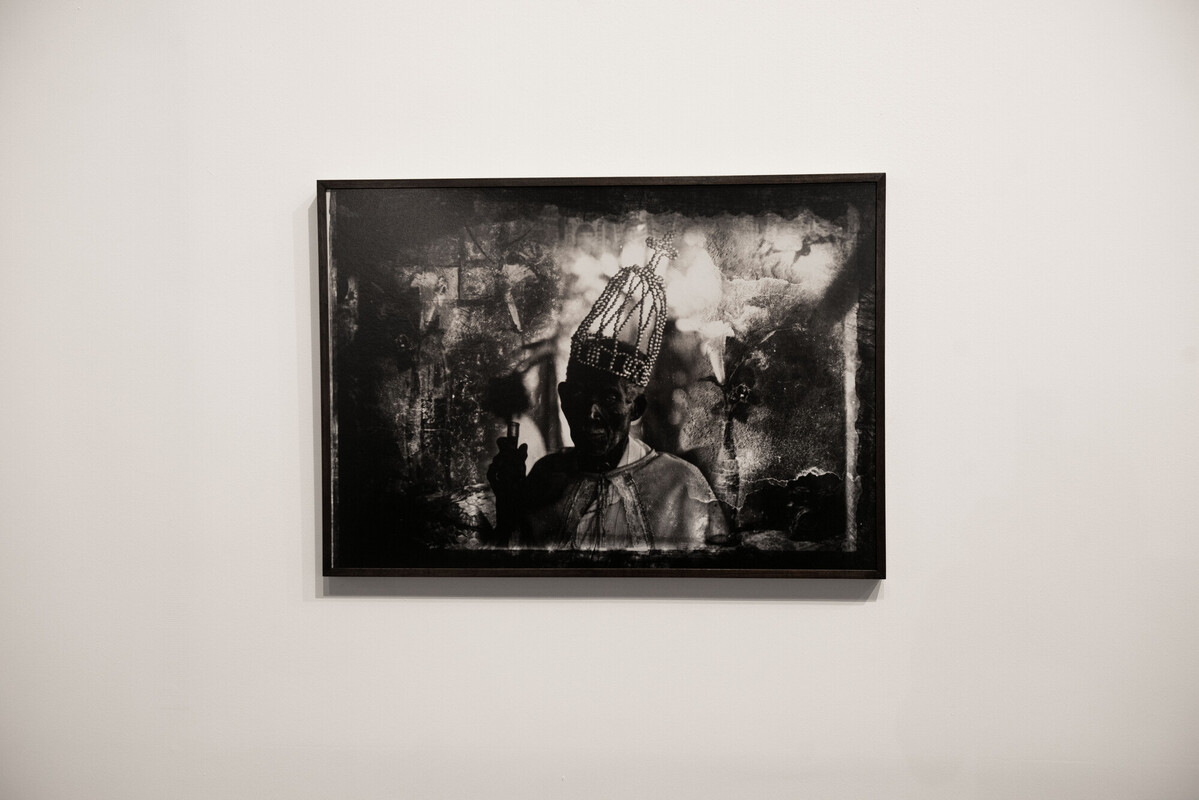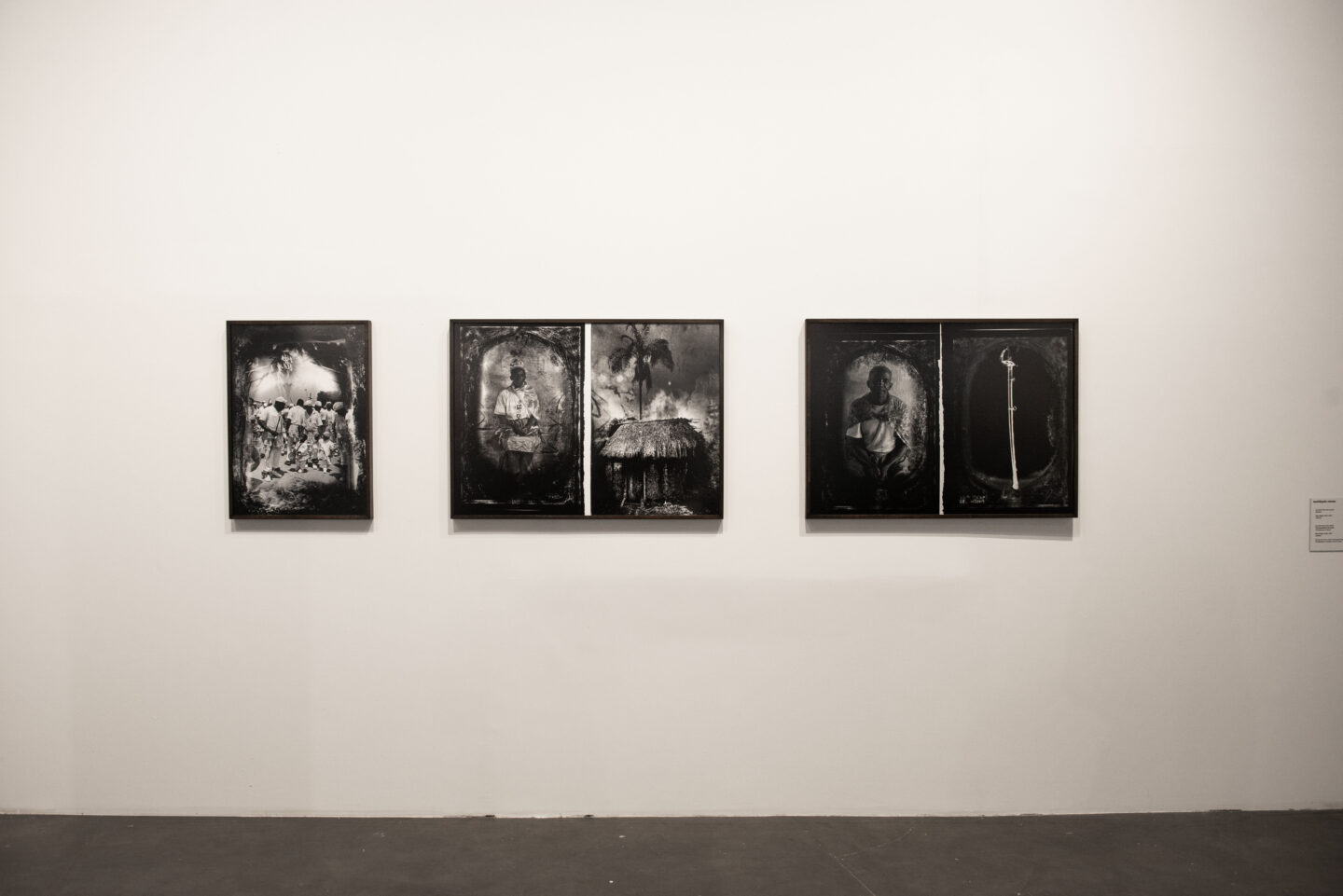
Eustáquio Neves
Eustáquio Neves’ tenacity in observing and researching the rites and festivities of the remaining Black communities makes him a remarkable restorer of memories. The series Arturos (1993-94) and the diptychs Encomendador de almas [Commissioner of Souls] (2006-07), presented at the 35th Bienal, document a comprehensive view of the sacred, of hereditary education and of the daily life of these communities.
Thanks to his knowledge of chemical processes, acquired through his technical training, Neves manually interferes with the negatives of photographs to produce various effects. It is an enigmatic, almost Lomographic gesture that penetrates the workings of the equipment and exposes the indeterminable and choreographic character of the gaze that composes them. In the early 1990s, Neves produced the series Arturos, depicting a family group reminiscing about their oldest ancestor, Artur, in the municipality of Contagem, Minas Gerais. This group is characterized by its sacred practices, based on the intersection of Catholicism with religions of African origin, during the celebration of Our Lady of the Rosary, protector of Black brotherhoods in colonial Brazil. In the first photo, there is a group of adults with children in the center, all elegantly dressed.
The second photo depicts a man of the guard, in an upright and central position, and in the third, The King, framed in a bust, wears a crown and a cloak. The second work presented is from the series Encomendador de almas and portrays the quilombola community in Ausente or Córrego do Ausente, located near the district of Milho Verde, in the Vale do Jequitinhonha region. The encomendador de almas is a figure present in the festivities of Our Lady of the Rosary and is responsible for the work songs called vissungos. In the diptychs displayed at the Bienal, one of them shows Mr. Crispim, a very important person in the hierarchy of the catopê (the name given to the Congadas in the region of Minas Gerais), seated, wearing a light blouse and a cloak covering his shoulders, his hands joined over his legs. Next to him is a photo of a sword used to clear the way for the procession of Our Lady of the Rosary. In the second diptych, Mr. Antonio appears next to his house.
Neves’ images defy the technical limits of photography and perform “a reality that cannot be named,” as described by the authorial voice of the 35th Bienal’s educational publication.1 The remaining peoples are an extension of quilombismo and, by reconstituting time periods and characters in an apparently static memory, Neves signals a recovery of traditions and landscapes, as well as the very incongruity of the construction of memory.
horrana de kássia santoz
translated from Portuguese by mariana nacif mendes
Eustáquio Neves (Juatuba, MG, Brazil, 1955. Lives in Diamantina, MG, Brazil) develops an experimental language marked by the chemical manipulation of negatives and prints, often mixing fragments from several different negatives. His work addresses Afro-Brazilian identity and memory – the subject of essays such as Arturos (1994), in which he portrayed a Black community derived from quilombos in Contagem (MG), Futebol (1998) and Objetivação do corpo (1999). In Retrato falado (2019), a project that won the ZUM/IMS Photography Grant 2019, he reconstructed the portrait of his grandfather, whom he did not know and of whom he has no images in the family albums, from descriptions by relatives and analog and digital resources of photographic manipulation. He is a chemist by training. He received the Marc Ferrez Photography Award from Funarte in 1994 and has exhibited in shows such as the 5th Rencontres de la Photographie Africaine (Bamako, Mali), and the 2nd Biennial of the Tokyo Metropolitan Museum of Photography (Japan). His works are part of the collections Pirelli/Masp, MAM-SP, Itaú Cultural, Museu Afro Brasil (São Paulo, Brazil), among others.
1. Reference to the phrase “a reality that I cannot name,” in “Correspondências entre vozes, uma carta para abrir conversas”, in Aqui, numa coreografia de retornos, dançar é inscrever no tempo: educational publication of the 35th Bienal de São Paulo – choreographies of the impossible. São Paulo: Bienal, 2023, p. 15.
- Vista de obras de Eustáquio Neves durante a 35ª Bienal de São Paulo – coreografias do impossível © Levi Fanan / Fundação Bienal de São Paulo
- Vista de obra de Eustáquio Neves durante a 35ª Bienal de São Paulo – coreografias do impossível © Levi Fanan / Fundação Bienal de São Paulo
- Vista de obra de Eustáquio Neves durante a 35ª Bienal de São Paulo – coreografias do impossível © Levi Fanan / Fundação Bienal de São Paulo
- Vista de obra de Eustáquio Neves durante a 35ª Bienal de São Paulo – coreografias do impossível © Levi Fanan / Fundação Bienal de São Paulo
- Vista de obra de Eustáquio Neves durante a 35ª Bienal de São Paulo – coreografias do impossível © Levi Fanan / Fundação Bienal de São Paulo

 Português
Português



